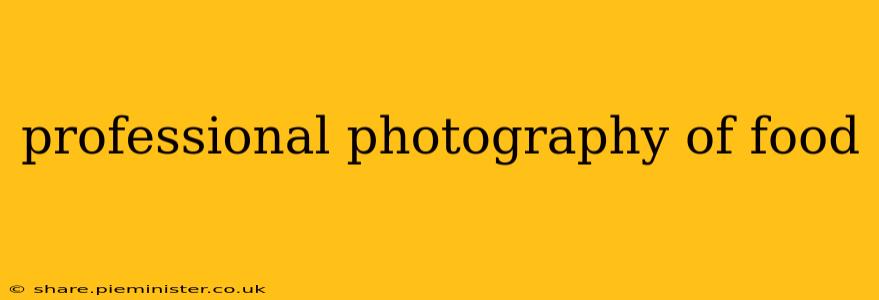Professional food photography is more than just snapping a picture of a plate of food; it's about creating a visual narrative that evokes emotion and entices the viewer. It's a blend of art, culinary knowledge, and technical skill, resulting in images that are both visually stunning and commercially effective. Whether you're a restaurant owner, food blogger, or aspiring photographer, understanding the key elements of professional food photography is crucial to success. This comprehensive guide will delve into the techniques and considerations that elevate food photography from snapshots to works of art.
What Makes Professional Food Photography Different?
The difference between a casual food photo and a professional one is significant. Professional food photography goes beyond simply capturing the food; it carefully considers lighting, styling, composition, and post-processing to create images that are both aesthetically pleasing and appetizing. It's about selling the experience, the feeling, and the story behind the dish, not just the dish itself.
How to Style Food for Professional Photography
Food styling is a crucial element in achieving professional-looking food photography. It's about making the food look its absolute best, often involving subtle enhancements to texture, color, and presentation. This might involve:
- Using props: Carefully chosen props, like plates, cutlery, and linens, can significantly enhance the overall visual appeal.
- Adding garnishes: Strategically placed garnishes can add vibrancy and visual interest.
- Adjusting textures: Food stylists often use techniques to improve the texture and appearance of the food, ensuring it looks fresh and appealing.
- Creating a narrative: The styling should reflect the mood and concept of the shoot.
What Equipment is Needed for Professional Food Photography?
While you can achieve great results with a good DSLR or mirrorless camera, professional food photography often requires specific equipment:
- High-quality camera: A camera with excellent image quality and a wide range of aperture settings is essential.
- Macro lens: A macro lens allows for detailed close-up shots that capture the texture and detail of the food.
- Lighting equipment: Professional food photographers often use studio lighting, such as strobes or continuous lighting, to precisely control the light and shadows.
- Reflectors: Reflectors are used to bounce light onto the food, softening shadows and highlighting textures.
What are the Best Lighting Techniques for Food Photography?
Lighting is paramount in food photography. Natural light can be beautiful, but often requires careful positioning to avoid harsh shadows. Professional setups often utilize:
- Soft, diffused light: This type of light minimizes harsh shadows and creates a more even, appealing look.
- Backlighting: Backlighting can create a beautiful rim light, enhancing the three-dimensionality of the food.
- Side lighting: Side lighting accentuates textures and creates depth.
What is the best camera setting for food photography?
The optimal camera settings for food photography depend on your specific lighting conditions and desired effect. Generally, a smaller aperture (like f/8 or f/11) will maximize depth of field, keeping everything in focus. A lower ISO setting minimizes noise.
How do I edit my food photos professionally?
Post-processing is crucial in enhancing the final image. Professional editors use software like Adobe Lightroom or Photoshop to adjust brightness, contrast, saturation, and sharpness. They might also employ techniques like dodging and burning to refine highlights and shadows.
What are some tips for taking better food photos?
- Cleanliness is key: Ensure your food and surroundings are spotless.
- Shoot from various angles: Experiment with different angles and perspectives to find the most flattering view.
- Pay attention to detail: Small details can make a big difference in the overall impact of your photograph.
- Practice makes perfect: The more you shoot, the better you will become at understanding light, composition, and styling.
Conclusion:
Professional food photography is a multifaceted discipline that requires skill, patience, and attention to detail. By mastering the techniques discussed above, and constantly refining your skills through practice and experimentation, you can create mouthwatering images that capture the essence of the culinary arts. Remember, the goal is not just to show the food, but to tell its story and make the viewer crave a bite.
